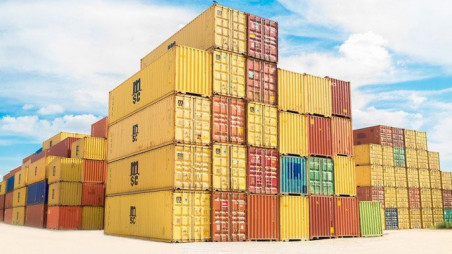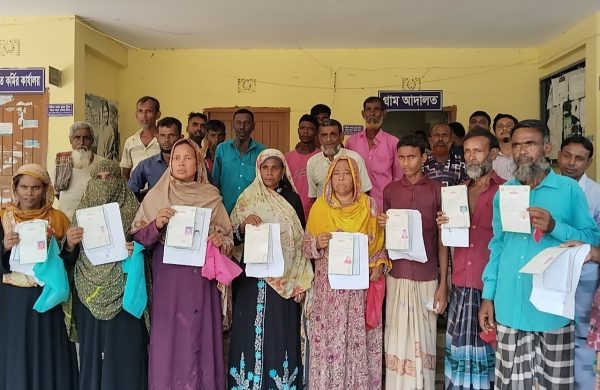Exports to India rise despite restrictions
- Update Time : Saturday, August 16, 2025

TDS Desk:
Despite India imposing various restrictions, Bangladesh’s export earnings from the country increased in July. However, the situation is different in different sectors.
Exports of ready-made garments, plastics and a few other items went up, while exports of jute, jute-based goods and food products dropped significantly.
According to the National Board of Revenue (NBR), Bangladesh exported goods worth USD 149.4 million (USD 14.94 crore) to India in July this year, which is four per cent higher compared to the same period last year.
India had earlier imposed restrictions on the use of land ports for exports of Bangladeshi goods. At the time, there were fears that Bangladesh’s exports to the Indian market would decline, since shipments by sea take longer.
The data now shows that certain sectors have indeed been affected, though ready-made garments and some other products have largely remained unaffected.
AKH Group, which exports garments to India and other countries, echoed this. Deputy managing director of the company, Md Abul Kashem, told journalist “Our garment factories have greater capacity. Moreover, the cost of transporting garments by sea is borne by Indian buyers. The restrictions at land ports will not affect garment exports.”
According to the Export Promotion Bureau (EPB), India was Bangladesh’s eighth largest export market in the 2024–25 fiscal year. In this fiscal, Bangladesh exported goods worth USD 1.76 billion (USD 176 crore) to India, which is 12.43 per cent higher compared to the previous fiscal.
India accounts for 3.65 per cent of Bangladesh’s total export earnings. In comparison, Bangladesh’s larger export markets are the United States, Germany, the United Kingdom, Spain, France, the Netherlands and Poland.
Trade analysts have often noted that Bangladesh’s exports to India are relatively small compared to its total export earnings of USD 48.28 billion (USD 4,828 crore). However, these restrictions pose a threat for factories that rely heavily on the Indian market. Workers in those factories may face job losses.
The government, however, maintains that India’s restrictions are unlikely to cause significant loss to Bangladesh’s overall export sector. Trade adviser Sk Bashir Uddin told journalists at the Secretariat on 12 August that while Bangladesh has written to India’s Ministry of Commerce to strengthen bilateral trade ties, no response had yet been received.
INDIA’S RESTRICTIONS
India, in the past four months, has imposed restrictions three times on the export of Bangladeshi goods through land ports. Restrictions were placed on the export of garments, food items, jute products, cotton waste, plastic products, and wooden furniture in two phases on 17 May and 27 June. Then in the third phase, India imposed further restrictions on a number of jute products on 11 August.
According to the restrictions, jute and garment products from Bangladesh can no longer be exported into India through the land ports. These must be shipped exclusively through the country’s Jawaharlal Nehru Port (Nhava Sheva) in Mumbai.
In addition, food products, soft drinks, wooden furniture, cotton waste, and plastic items can only be exported through land ports connected to West Bengal, with the exception of Burimari and Banglabandha. These items are not permitted for export through land ports in Assam, Meghalaya, Tripura, or Mizoram.
Garments account for around 35 per cent of Bangladesh’s total export earnings from India. Before the restrictions, approximately 30 per cent of Bangladeshi garments exported to India were shipped by sea, 69 per cent through land ports, and around 1 per cent by air. Following the restrictions, nearly all garment exports are now being routed by sea.
According to NBR data, 324 exporting companies from Bangladesh shipped garments worth USD 52.8 million (USD 5.28 crore) to India in July last year, one and a half months after the restrictions were imposed. Meanwhile, 388 companies exported garments worth USD 62.8 million (USD 6.28 crore) during the same period this year, indicating a 19 per cent increase.
Major buyers of Bangladeshi garments in India include at least 15 multinational brands such as H&M, M&S, Puma, Uniqlo, Decathlon, Pepe Jeans, Mango Fashion, and Bestseller. Commenting on the trend, Md M Mohiuddin Chowdhury, director and CEO of Clifton Group, a successful Bangladeshi garment exporter, told journalist that exports had risen thanks to Bangladesh’s ability to supply apparel at competitive prices.
NBR data also shows that Bangladesh’s exports of plastic goods, wooden furniture, and cotton waste to India was around USD 5.3 million (USD 53 lakh) in July this year. This accounts for a 95 per cent increase in exports compared to the same month last year.
CRISIS IN JUTE EXPORTS TO INDIA
Bangladeshi jute products were exported to India mainly through land ports, with only a few consignments sent via Chattogram seaport. Under the new rules, jute products can now only be exported by sea through India’s Nhava Sheva port in Mumbai.
According to NBR data, before the restrictions, Bangladesh exported jute goods worth USD 12.9 million (USD 1.29 crore) to India in July last year. That figure has now fallen by 74 per cent to exports worth around USD 3.4 million (USD 34 lakh).
An analysis of the data shows that 47 companies could not export even a single consignment after the restrictions, while three companies started exporting anew. One of the affected companies is Hasan Jute and Spinning Mills Limited from Kahalu area in Bogura. Another company under the same ownership, Hasan Jute Mills, managed to export some consignments though.
ATM Shafiqul Hasan, managing director of the two companies, told journalist “After the Indian restrictions, we exported three consignments through Chattogram seaport on trial basis. The consignments have not reached the Nhava Sheva port even after a month.”
India has kept limited scope for food exports, allowing them only through Bhomra and Hili land ports, or by sea. Exports through all other land ports remain prohibited. NBR data shows that 19 companies exported biscuits and beverages worth USD 4.1 million (USD 41 lakh) in July last year. After the restrictions, only 14 companies were able to continue exports, and the total fell by 17 per cent to about USD 3.4 million (USD 34 lakh).
India’s Assam and Tripura were the key markets for BSP Food Products Limited based in Chattogram. With no scope to export through those land ports, the company has not been able to send a single consignment. Its managing director, Ajit Kumar Das, told journalist on Wednesday that the number of their factory workers had dropped from 150 to just 60.
PRAN-RFL Group is one of the largest Bangladeshi food exporters. Compared to July last year, the group’s exports to India fell by 14 per cent this July with exports worth USD 3.145 million (USD 31.45 lakh). Other companies including Akij Food & Beverage, Ifad Multi Products, TK Food Products, and Hashem Foods Limited also reported a decline.
When asked about the situation, marketing director of PRAN-RFL Group, Kamruzzaman Kamal, said, “Sending products through alternative routes has increased the costs by 8 to 9 per cent. This issue should be addressed as a top priority through bilateral discussions.”
PRESSURE MOUNTS ON CHITTAGONG PORT
In the last fiscal year, 83 per cent of Bangladesh’s total exports to India were carried out through land ports, while only 16.5 per cent went through seaports. Following the new restrictions, pressure on Chattogram Port has increased significantly.
In this July, 89 per cent of the goods subject to India’s restrictions were routed through Chattogram Port, while just 11 per cent were exported via land ports. As exports through seaports continue to rise, container congestion at the port has increased since last month.
Of these goods, food products are sent through the Bhomra and Hili land ports only. Meanwhile, plastic, furniture, and cotton by-products are exported through Benapole and Sonamasjid land ports.
In this situation, the government has now decided to shut down the land ports of Chilahati in Nilphamari, Daulatganj in Chuadanga, and Tegamukh in Rangamati. Operations at Balla land port in Habiganj are also to be suspended. These decisions were taken at an inter-ministerial meeting held on 28 July, chaired by planning adviser Wahiduddin Mahmud.
‘TRADE BARRIERS MUST BE REMOVED’
It was India that first imposed restrictions on trade with Bangladesh. On 8 April, it scrapped Bangladesh’s transshipment facility, under which Dhaka could export goods to other countries using Indian airports. Then on 15 April, Bangladesh responded by halting the import of yarn through land ports.
Mustafizur Rahman, distinguished fellow at the Centre for Policy Dialogue (CPD), told journalist that such barriers should be removed through mutual understanding. This would be beneficial for both countries. However, it is not possible to predict the future trajectory of bilateral trade based on the data of just one month, he said.















